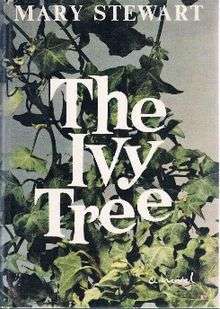The Ivy Tree

The Ivy Tree is a novel of romantic suspense by English author Mary Stewart. Her sixth novel, it was published in 1961 in Britain by Hodder & Stoughton and in 1962 in the United States by William Morrow. As usual with the author, the novel is narrated in first person by a bold and intelligent young woman, and the setting is picturesque - in this case, Northumberland.
Characters
Mary Grey, protagonist: a new arrival in England from Canada, working in the Kasbah cafe in Newcastle and renting an old run-down flat. Her alternate identity (later confirmed to the reader) is Annabel Winslow: the well-liked but wayward favorite of her grandfather, Matthew (see below).
Connor Winslow, the handsome but hot-tempered and ruthless manager of Whitescar Farm.
Lisa Dermott, Connor's half-sister, loyal only to her brother and anxious that he become the Farm's heir.
Matthew Winslow, the elderly patriarch of Whitescar: the grandfather of Annabel and Julie and uncle to Connor. Although a stroke has weakened him and death is imminent, Matthew continues to control his household and enjoys keeping everyone in suspense regarding his final wishes to his heirs.
Julie Winslow is the pretty, vivacious young cousin of Annabel. Julie adores Annabel and freely confides about her feelings concerning Whitescar, her boyfriend Donald, and her knowledge of the affair between Annabel and Adam. When Connor threatens Julie, Annabel and Adam rescue her.
Archaeologist Donald Seton, Julie's boyfriend, is captivated with his work on Roman excavations, and his proportionate lack of attention towards Julie induces her to doubt if she and Donald will ever marry. When he almost dies in a cave-in on Forrest Hall property, his survival draws them closer.
Adam Forrest, owner of Forrest Hall, is a neighbor of the Winslow family, and sometime the paramour of Annabel, even during his wife's lifetime. At the end of the story, he is identified with the Biblical Adam.
Plot
Narrator/protagonist Mary Grey is off work on Sunday afternoon and enjoying the beauty of the northern English countryside. As she leans against Hadrian's Wall near a cliff overlooking the waters of Crag Lough, a local youth called Connor Winslow mistakes her for his long-lost cousin "Annabel".[1] Upon persuasion to the contrary, Connor is amazed at her resemblance to Annabel,[2] and offers Mary money to impersonate Annabel at the Northumberland family farm of Whitescar, in the hope that Annabel's grandfather, Matthew, will bequeath Whitescar and his financial estate to her, and that she in turn will transfer it, after Matthew's death, to Connor himself. For reasons only partially explained (to Connor and Lisa, as well as to the reader) she agrees, and succeeds in convincing the household - Grandfather Matthew, Connor's sister Lisa, cousin Julie, and Mr. and Mrs. Bates (employees of Whitescar) - that she is indeed Annabel. The sole weakness of this imposture is Mary's fear of horses, which contradicts Annabel's natural horsemanship; but this is soon rationalized by all the locals except Adam Forrest, the owner of nearby Forrest Hall, of whom the original Annabel was a paramour. When Adam discovers the long-lost Annabel after her late-night visit to the ivy tree (their former rendezvous), he discovers the imposture; but Mary persuades him to keep her identity secret as long as no one is hurt. In a later plot twist, a background story is introduced wherein Mary Grey was herself a double-identity assumed by the original Annabel Winslow. At the climax, Annabel tries to save Adam from a cave-in of an old cellar, and is later confronted by Connor; but he is killed by a nearby horse. In conclusion, Annabel and Julie are confirmed friends, Julie will marry her boyfriend, and Annabel and Adam are presumed to marry, and inherit Whitescar.
Reviews
Mary Stewart was already a popular author of romantic suspense and most reviewers felt that this novel was up to her standards. The Atlantic Monthly said, "The author has a neat touch with red herrings and cambric-tea romances." The Christian Science Monitor said: "If the reader feels cheated by the denouement, the author has earned forgiveness by her exciting, belief-suspending account of Mary Grey's sensitive groping for the right response to those who are more sure than the reader that they have known her all her life." The eminent mystery-novel critic Anthony Boucher said, "No one writes the damsel in distress tale with greater charm or urgency."
Jo Walton, in a conflicted but mostly negative critique ("It's very clever indeed, too clever for its own good. ... It's a load of nonsense, really"), compares and contrasts the novel with Josephine Tey's Brat Farrar, which "Stewart clearly has read and been influenced by".[3] Martin Edwards observes more neutrally that the "fraud in Brat Farrar is discussed and emulated in Mary Stewart's The Ivy Tree" in a section on the "Prodigal Son/Daughter" theme in the encyclopedia Whodunit? (2003).[4]
Notes
- ↑ Stewart, Mary. The Ivy Tree. William Morrow, 1962, p. 10.
- ↑ Stewart, Mary. The Ivy Tree. William Morrow, 1962, p. 13.
- ↑ Walton, Jo (September 14, 2010). "Eve dreaming of Adam: Mary Stewart's The Ivy Tree". Tor.com. Retrieved November 29, 2015.
- ↑ Edwards, Martin (2003). "Prodigal Son/Daughter". In Rosemary Herbert, ed. Whodunit? A Who's Who in Crime & Mystery Writing. Oxford: Oxford University Press. p. 159.
References
- Adams, Phoebe. The Atlantic Monthly, April 1962.
- The Christian Science Monitor, January 11, 1962.
- Boucher, Anthony. The New York Times Book Review, January 7, 1962.
- Stewart, Mary. The Ivy Tree. William Morrow, 1962.